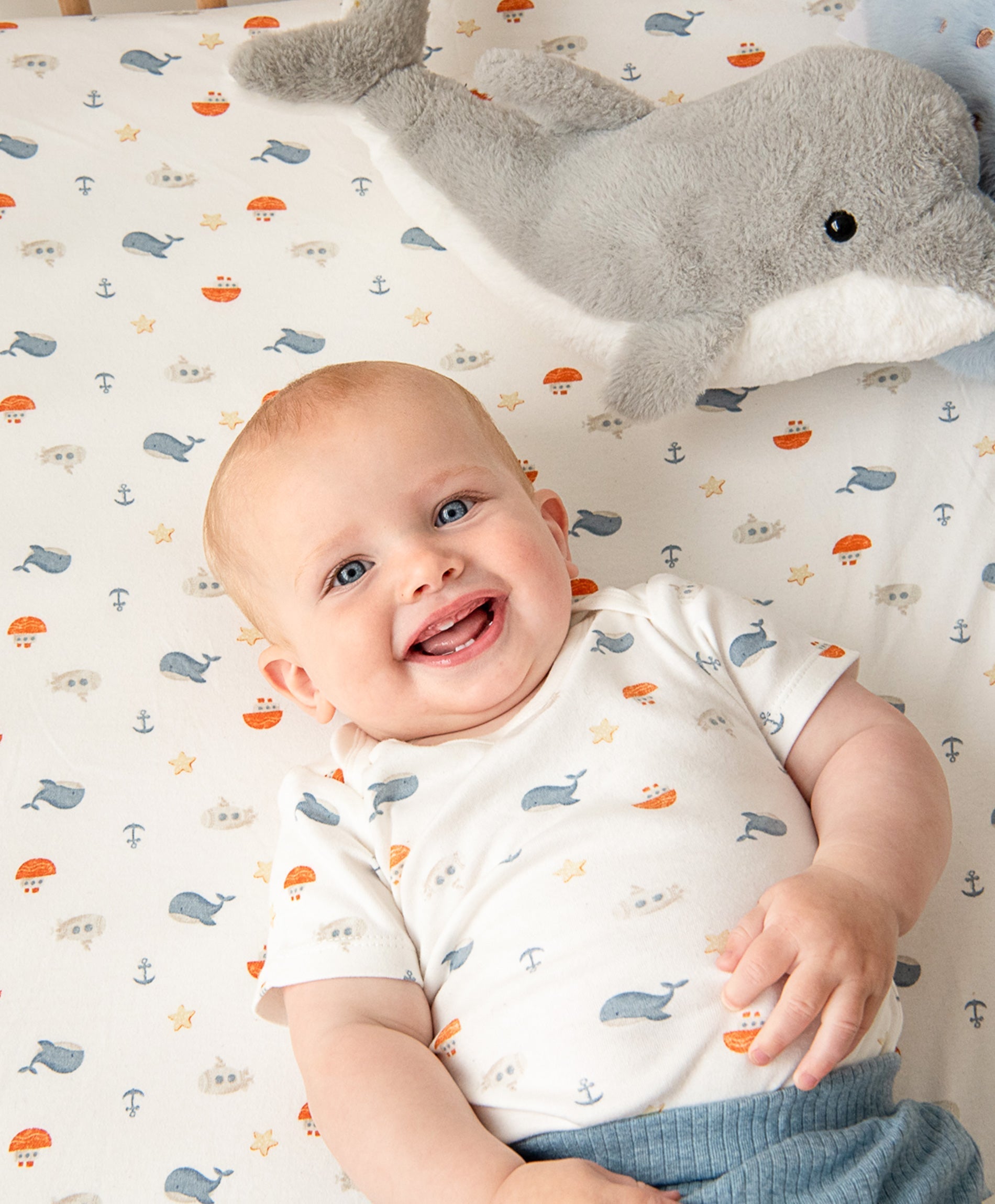Table of content
- 1. Fabric & Construction: The Science Behind Comfort
- 2. Seasonal Mastery: Dressing for Australia’s Unique Climate
- 3. Brand Deep Dive: Australian Parent-Approved Labels
- 4. Pro Care Protocol: Extending Romper Lifespan
- 5. 2025 Forecast: The Future of Baby Rompers
- 6. Australian-Specific Buying Checklist
Every parent understands the irreplaceable role of a well-crafted baby boy romper in their little one’s wardrobe. Far more than a simple garment, it’s a second skin that balances comfort, safety, and style. As an Australian mum with years of hands-on experience, I’ve curated this comprehensive guide to help you navigate the nuances of selecting, styling, and maintaining boy rompers, ensuring your baby thrives in every season and scenario.
Fabric & Construction: The Science Behind Comfort
The foundation of an exceptional baby romper lies in its materials and craftsmanship. Let’s dissect what truly matters:
Fabric Choices: Beyond Softness
- Organic Cotton: The gold standard for baby boy outfits, Lūmmi uses 100% GOTS-certified organic cotton that is pesticide-free, breathable, and ideal for eczema-prone skin. Look for 300+ thread count for durability.
- Bamboo Viscose: Naturally antibacterial and thermoregulating, bamboo fabric wicks moisture 40% faster than cotton—perfect for Australia’s humid summers.
- Merino Wool: A game-changer for winter, this lightweight yet insulating material (18.5 microns or finer) regulates body temperature without bulk.
- Hemp-Linen Blends: Emerging as a sustainable favorite, these blends soften with each wash while offering UPF 15+ sun protection.
Pro Tip: Check for Oeko-Tex Standard 100 certification to ensure fabrics are free from 350+ harmful substances.
Engineering the Perfect Fit
- Ergonomic Construction: Premium boy rompers feature diamond gussets at the crotch for unrestricted crawling and kick-friendly leg openings (minimum 10 cm elasticity).
- Seam Technology: 4-thread overlock seams prevent unraveling, while flatlock stitching eliminates inner ridges that could chafe delicate skin.
- Functional Closures: Magnetic snaps (rated for 10,000+ uses) allow silent nighttime diaper changes, while YKK® zippers with protective plackets prevent pinching.
Seasonal Mastery: Dressing for Australia’s Unique Climate
Australia’s weather demands strategic layering. Here’s how to adapt baby boy rompers year-round:
Summer Survival Kit
- Fabric: Opt for 100% linen or Tencel™ rompers with mesh ventilation panels under arms.
- Sun Protection: Choose UPF 50+ rated styles with integrated neck flaps and thumbhole sleeves.
- Hydration Hack: Look for rompers with silicone-coated inner layers to wick sweat away from skin.
Winter Warriors
- Layering System: Start with a merino wool base romper (150gsm), add a thermal mid-layer, and finish with a windproof outer shell.
- Critical Zones: Prioritize rompers with reinforced knees and double-layered seat areas for floor play.
- Thermal Tech: Phase-change materials (PCMs) like Outlast® absorb excess heat during active play and release it during rest.
Brand Deep Dive: Australian Parent-Approved Labels
Beyond global giants, support local innovators crafting boy rompers for Aussie conditions:
- Bonds WondersuitsSignature Tech: Cross-over shoulders + envelope necklines for easy dressingParent Hack: Fold-over mittens prevent face scratches during sleep
- Nature BabyEco Cred: Carbon-neutral production + compostable packagingInnovation: SeaCell™ fiber infused with seaweed extracts for skin nourishment
- Sprout OrganicSafety First: Nickel-free snaps + non-toxic vegetable dyesSize Range: 00000 (preemie) to 3T for extended wear
- Lūmmi in colour: Lūmmi is a globally certified organic product that features soft yet durable baby clothing, offering a range of items for both boys and girls.
Pro Care Protocol: Extending Romper Lifespan
Maximize your investment with these textile-preserving techniques:
Wash Cycle Science
- Frequency: Every 2-3 wears (unless soiled) to preserve fibers
- Detergent: Use pH-neutral formulas like EcoStore Baby (avoid optical brighteners)
- Water Temp: 30°C for cotton/linen; cold wash for wool to prevent felting
Stain Removal Matrix
| Stain Type | Treatment Protocol |
| Milk/Vomit | Blot, then apply baking soda paste (2:1 water ratio) |
| Poop | Sun-dry first, then soak in oxygen bleach |
| Fruit Stains | Dab with lemon juice before washing |
Storage Solutions
- Anti-Moth: Cedar rings in drawers (safer than naphthalene)
- Color Preservation: Wrap in acid-free tissue to prevent dye transfer
- Long-Term: Vacuum-seal off-season rompers with oxygen absorbers
2025 Forecast: The Future of Baby Rompers
Stay ahead with these emerging innovations:
- Smart TextilesBiomonitoring: Rompers with integrated graphene sensors tracking body temp/respirationSelf-Cleaning: TiO2 nanoparticle coatings break down organic stains under sunlight
- Circular DesignTake-Back Programs: Brands like Patagonia offer credit for returned outgrown rompersModular Systems: Interchangeable sleeves/legs adapt to growth spurts
- Climate-Responsive FabricsPhase-Change Materials: Maintain 32°C microclimate regardless of external tempsWaterless Dye Tech:* AirDye® systems using 95% less water than traditional methods
- Safety 2.0
Australian-Specific Buying Checklist
Before purchasing boy rompers, verify these local requirements:
✅ Compliance with AS/NZS 1249:2014 (Children’s Nightwear Safety Code)
✅ Sun protective clothing rated AS/NZS 4399:2020
✅ TGA-approved antimicrobial treatments (for eczema-friendly claims)
✅ Ethical sourcing aligned with Australian Modern Slavery Act 2018
Final Thought: A baby boy romper is more than clothing—it’s a tool for exploration. By combining material science with thoughtful design, modern parents can create a wardrobe that adapts to their child’s developmental milestones while respecting our planet’s boundaries.
What fabric is safest for newborn rompers?
Answer: 100% organic cotton with GOTS certification is recommended. The American Academy of Pediatrics advises breathable fabrics to prevent overheating.
How do snap closures affect baby's skin?
Answer: Nickel-free snaps are essential. The National Eczema Association warns against metal allergens in clothing fasteners.
What's the ideal romper sleeve length for different seasons?
Answer: Follow the CDC's infant temperature guidelines - short sleeves above 24°C/75°F, long sleeves below 20°C/68°F.
How to prevent romper shrinkage?
Answer: Cold water washing preserves fabric integrity.
How often should rompers be replaced?
Answer: The Textile Industry Association recommends replacement after 80-100 washes or visible pilling.
Read More:The Ultimate Guide to Baby Rompers: Styles, Benefits, and Buying Tips











